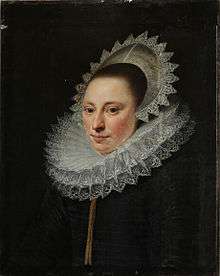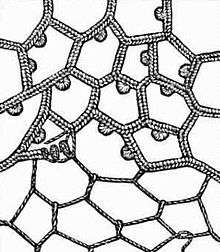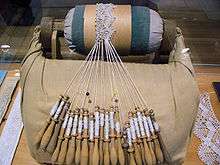Lace
Lace is a delicate fabric made of yarn or thread in an open weblike pattern,[1] made by machine or by hand.
Originally linen, silk, gold, or silver threads were used. Now lace is often made with cotton thread, although linen and silk threads are still available. Manufactured lace may be made of synthetic fiber. A few modern artists make lace with a fine copper or silver wire instead of thread.
Etymology
The word lace is from Middle English, from Old French las, noose, string, from Vulgar Latin *laceum, from Latin laqueus, noose; probably akin to lacere, to entice or ensnare.[1]
Types


There are many types of lace, classified by how they are made. These include:
- Bobbin lace, as the name suggests, is made with bobbins and a pillow. The bobbins, turned from wood, bone, or plastic, hold threads which are woven together and held in place with pins stuck in the pattern on the pillow. The pillow contains straw, preferably oat straw or other materials such as sawdust, insulation styrofoam, or ethafoam. Also known as bone-lace. Chantilly lace is a type of bobbin lace.
- Chemical lace: the stitching area is stitched with embroidery threads that form a continuous motif. Afterwards, the stitching areas are removed and only the embroidery remains. The stitching ground is made of a water-soluble or non-heat-resistant material.
- Crocheted lace includes Irish crochet, pineapple crochet, and filet crochet.
- Cutwork, or whitework, is lace constructed by removing threads from a woven background, and the remaining threads wrapped or filled with embroidery.
- Knitted lace includes Shetland lace, such as the "wedding ring shawl", a lace shawl so fine that it can be pulled through a wedding ring.[2]
- Knotted lace includes macramé and tatting. Tatted lace is made with a shuttle or a tatting needle.
- Machine-made lace is any style of lace created or replicated using mechanical means.
- Needle lace, such as Venetian Gros Point, is made using a needle and thread. This is the most flexible of the lace-making arts. While some types can be made more quickly than the finest of bobbin laces, others are very time-consuming. Some purists regard needle lace as the height of lace-making. The finest antique needle laces were made from a very fine thread that is not manufactured today.
- Tape lace makes the tape in the lace as it is worked, or uses a machine- or hand-made textile strip formed into a design, then joined and embellished with needle or bobbin lace.
 Needle lace, showing button hole stitch
Needle lace, showing button hole stitch Bobbin lace made on a pillow with bobbins and pins
Bobbin lace made on a pillow with bobbins and pins.jpg) Broderie anglaise, a type of cutwork
Broderie anglaise, a type of cutwork Filet lace, embroidered on an existing net
Filet lace, embroidered on an existing net
- Tatting, with shuttle
History
The origin of lace is disputed by historians. An Italian claim is a will of 1493 by the Milanese Sforza family.[4] A Flemish claim is lace on the alb of a worshiping priest in a painting about 1485 by Hans Memling.[5] But since lace evolved from other techniques, it is impossible to say that it originated in any one place.[6]
The late 16th century marked the rapid development of lace, both needle lace and bobbin lace became dominant in both fashion as well as home décor. For enhancing the beauty of collars and cuffs, needle lace was embroidered with loops and picots.[7]
Lace was used by clergy of the early Catholic Church as part of vestments in religious ceremonies but did not come into widespread use until the 16th century in the northwestern part of the European continent.[8] The popularity of lace increased rapidly and the cottage industry of lace making spread throughout Europe. In 1840, Britain's Queen Victoria was married in lace, influencing the wedding dress style until now.[9] In North America in the 19th century, missionaries spread the knowledge of lace making to the Native American tribes.[10] St. John Francis Regis guided many women out of prostitution by establishing them in the lace making and embroidery trade, which is why he became the Patron Saint of lace making.[11]
The English diarist Samuel Pepys often wrote about the lace used for his, his wife's, and his acquaintances' clothing, and on 10 May 1669, noted that he intended to remove the gold lace from the sleeves of his coat "as it is fit [he] should", possibly in order to avoid charges of ostentatious living.[12]
Catherine of Aragon while exiled in Ampthill, England, was said to have supported the lace makers there by burning all her lace, and commissioning new pieces.[13] This may be the origin of the lacemaker's holiday - Cattern's day. On this day (25 or 26 November) lacemakers were given a day off from work, and Cattern cakes - small dough cakes made with caraway seeds, were used to celebrate.[14]
Patrons and lace makers
Historic
- Giovanna Dandolo (1457–1462)
- Barbara Uthmann (1514–1575)
- Morosina Morosini (1545–1614)
- Federico de Vinciolo (Sixteenth-century)
- Lacemaker (unidentified) in painting by the Dutch artist Johannes Vermeer (1632–1675), completed around 1669–1670.
Contemporary
See also
References
- "Lace". The Free Dictionary. Retrieved 23 May 2012.
- Lovick, Elizabeth (2013). The Magic of Shetland Lace Knitting. New York: St. Martin's Griffin. p. 10. ISBN 978-1-250-03908-8.
- "Hans Memling | La Vierge et l'Enfant entre saint Jacques et saint Dominique". Site officiel du musée du Louvre (in French).
- Verhaegen, Pierre (1912). La Dentelle Belge (in French). Brussel: L. Lebègue. p. 10.
- van Steyvoort, Collette (1983). Inleiding to kantcreatie (Introduction to creating lace) (translation by Magda Grisar ed.). Paris: Dessain et Tolra. p. 11. ISBN 224927665X.
- "The Origins of Lace". LaceGuild.org. Archived from the original on 13 February 2015. Retrieved 7 January 2015.
- "History of Lace | Lace Trends | Lace Spreads". Decoratingwithlaceoutlet.com. Archived from the original on 8 March 2014. Retrieved 11 September 2012.
- "History of Lace". www.lacemakerslace.oddquine.co.uk.
- The Fashion Book. London: Dorling Kindersley. 2014. p. 46. ISBN 9781409352327. OCLC 889544401.
- "Indian Lace". 1 August 2013. Archived from the original on 1 August 2013.
- "Society of Jesus Celebrates Feast of St. John Francis Regis, SJ". jesuits.org. Retrieved 8 May 2017.
- Pepys, Samuel (10 May 1669). "Monday 10 May 1669". The Diary of Samuel Pepys. Retrieved 7 January 2015.
- "St Catherine's Day, Cattern Cakes and Lace". Lavender and Lovage. 12 April 2017.
- Jones, Julia (1987). A Calendar of Feasts; Cattern cakes and lace. England: DK. ISBN 0863182526.
External links
| Wikimedia Commons has media related to Lace. |

